There was a time when legal barriers kept men from working as nurses and “nursing schools often refused to admit men.” It took a Supreme Court ruling in 1982 to change that, the report Men in Nursing Occupations recounted. These days it’s hard to imagine that it was ever so. Male Registered Nurses now constitute “a relatively small but growing minority in the nursing workforce”. But how many male nurses are there, exactly?
Sources and surveys
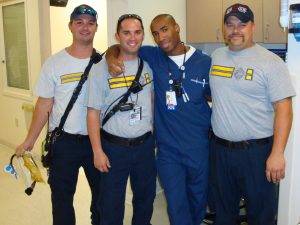
The question turns out to be surprisingly difficult to answer. Data about the number of men and women who are employed or have been trained as nurses is being collected by different organizations in different ways. In 2013, for example, the National Council of State Boards of Nursing and the Forum of State Nursing Workforce Centers conducted an in-depth “national workforce survey” which involved approaching over 100,000 licensed RNs.
The main source for relevant data is the U.S. government, but that hardly narrows things down. Data are gathered through the annual Current Population Survey, the annual American Community Survey, and the decennial Census, and tabulated in different ways (for example using data from just the most recent year or pooled data from over several years). Each type of survey and analysis uses different methodologies, different definitions, and breaks down the data in different levels of detail. For example, practically all recent publications break down the numbers separately for Registered Nurses and Licensed Practical/Vocational Nurses, but not all publications also specifically set apart Nurse practitioners, Nurse anesthetists and Nurse midwives.
And that’s not all! For example, do you only count nurses who are currently employed, or more specifically those who are employed full-time? Or do you also include nurses who are currently unemployed but who last worked as a nurse and are still actively looking for a job? Or do you use a different approach altogether and count all those who hold active RN licenses, whether they are currently practicing nursing or not?
The number and percentage of male nurses
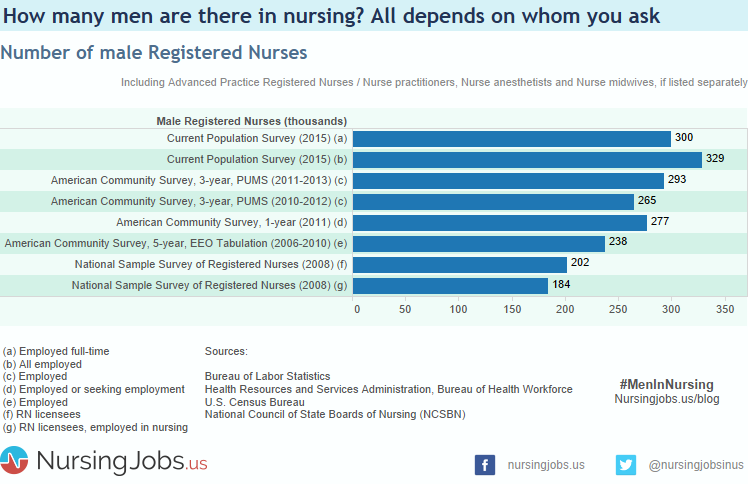
In the above chart, you can easily see how different choices and methodologies lead to vastly different numbers. In short, the number of male RNs is currently… well, somewhere between 185 thousand and 330 thousand. That really clears things up, doesn’t it? The most recent numbers are all nearer to the upper end of those numbers though. If you only look at data from the last five years, the number is somewhere between 265 thousand and 330 thousand.
There is more agreement about how large a share of all RNs men make up these days. In 2015 the Current Population Survey, a monthly household survey conducted by the Census Bureau for the Bureau of Labor Statistics, found that on average 10.5% of all employed RNs was male, once you include Nurse practitioners. The number edges up to 11.9% if you only look at full-time employees.
Those numbers are only a little higher than the ones from other data sources. The Census Bureau also conducts an annual American Community Survey (ACS), and data from this survey is often pooled across several years to make it more reliable. The Health Resources and Services Administration (HRSA), another U.S. government agency, published numbers about the “Sex, Race, and Ethnic Diversity of U.S. Health Occupations” that were taken from ACS data from 2010-2012, and found that 9.4% of all Registered Nurses were male, when including Advanced Practice Registered Nurses. By now there is similar ACS data from 2011-2013, and although it takes more of an effort to figure it all out, it suggests that the percentage increased a little to 9.7%. That’s all in line with ACS the data from 2011 (9.6% male, when including Nurse practitioners and Nurse anesthetists) and an analysis of pooled American Community Survey data from 2006-2010 (9.1% male, again including Nurse practitioners and Nurse anesthetists) – especially when you take into account that this data is a bit older.
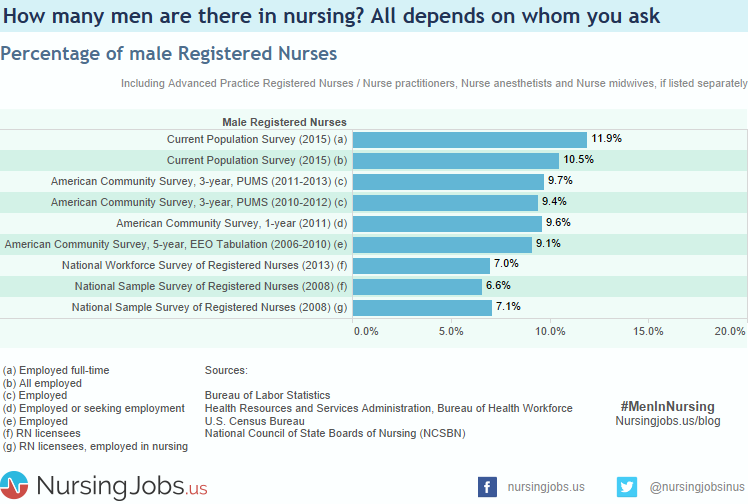
How to identify a nurse?
Two sources identified a significantly smaller percentage of male RNs, however. According to the National Sample Survey of Registered Nurses (NSSRN), the most recent one of which was conducted back in 2008, only 6.6% of licensed RNs were men. According to the more recent National Workforce Survey of Registered Nurses (NWSRN), it was just 7.0%. But those surveys took a very different approach, which raises an interesting question: when is a nurse, a nurse? It’s also a rather convoluted question though, so if you’d rather not sweat the details, skip to the next paragraph…
What you have to know is that the Census Bureau collects information from people in all professions and all walks of life, and then breaks down the professions those people say they work in. It also goes about this task household by household, rather than individual by individual, talking to one person in a household and asking them about the others in the house.
These two surveys did something different. They first identified the number of licensees, compiling a huge database of them, and then approached a significant number of those licensees to ask them who they were and where they worked.
The authors of the 2008 NSSRN report highlighted how its data and ACS data from the same year would be hard to compare because “differences in the way the data have been collected that could affect the quality or comparability of the estimates”. For example, they pointed out, “the ACS categorizes occupation as the main type of work a person did if the person worked in the previous 5 years. The NSSRN collects data on RNs with currently active licenses regardless of current or past employment status.”
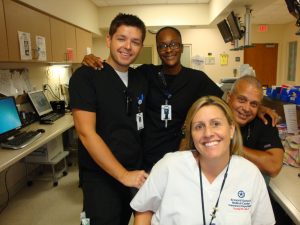
On the one hand, this approach guarantees that those who are surveyed do in fact hold a RN license, instead of relying on how people or family members identify their profession. With the Census Bureau interviewers, the authors argue, there is always the chance that “a household respondent may be characterizing another household member inaccurately.” For example, they might be confused about whether their family member is an RN or an LPN.
On the other hand, it pulls in a high number of people who hold a license but are not currently employed in the profession. That’s why the NSSRN also provided separate data on the gender and race/ethnicity of those currently employed in nursing, but the published NWSRN data doesn’t seem to do so.
Both these surveys, and especially the NWSRN, also struggled with response rates. More than 100,000 licensed RNs were contacted for the NWSRN, but only 42,294 responded – a rate of 39%. That’s very impressive when compared to, say, political opinion polls, but a whole lot lower than the kind of response rate the Census Bureau can achieve (in 2008, for example, the ACS had a 98% response rate). This can create problems. For example, a so-called nonresponse bias analysis of the NWSRN data revealed that white, female, and older nurses “may have been slightly overrepresented”. The NSSRN seems to have struggled with an overrepresentation of older respondents, using sample weights to correct for it. That’s probably relevant, since women make up a higher share of older nurses than younger nurses.
Almost in the Top 10 of most female-dominated occupations
With all the above in mind, what we know fairly certainly is that somewhere between 7% and 11% of RNs in the U.S. are male. That’s obviously still a pretty low percentage, and a report by the HRSA on “trends in supply and education” of nurses found that the percentage is somewhat lower still in rural (7.8%) than in urban (9.4%) areas.
It’s not just nurses though. Men are clearly outnumbered in the whole sector of health occupations. The other HRSA report mentioned earlier observed that women represented the majority of workers in 27 out of 32 health occupations, and accounted for more than 80% of workers in fifteen of these occupations.
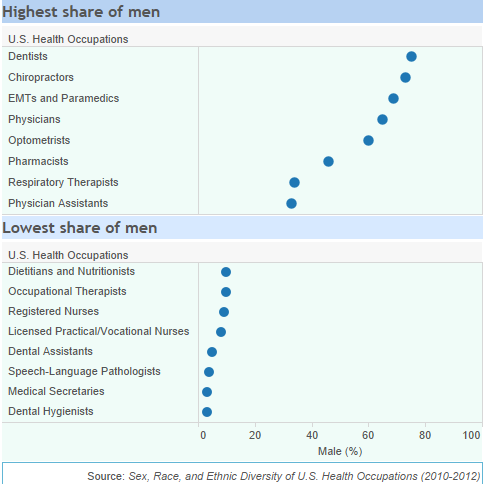
The only five health occupations in which men made up the majority of employees were dentists, chiropractors, EMTs and paramedics, physicians, and optometrists. Just four health occupations were more female-dominated than RNs and LPNs/LVNs: dental hygienists (97%), medical secretaries (97%), speech-language pathologists (96%), and dental assistants (95%). (The only management occupation in this list, Medical and Health Services Managers, had 70% women, 30% men.)
According to the 2014 Current Population Survey, men constituted just over a quarter of all employed persons in the whole spectrum of “healthcare practitioner and technical occupations”. That’s still over double their share among Registered Nurses though. In fact, RNs almost make the Top 10 of most female-dominated occupations of note in the country. According to the 2015 edition of “Women in the labor force: a databook,” exactly ten occupations which employ over 200,000 people have a higher share of women than Registered Nurses. The full list?
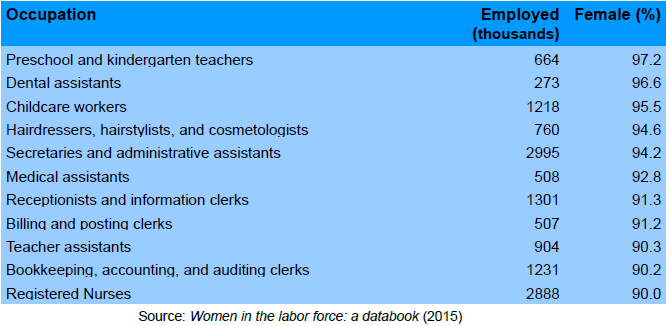
The U.S. number is low compared to other parts of the world as well. While the proportion of male nurses in Australia (7.2%) and the United Kingdom (10.1%) was, at least back in 2005, only slightly higher than in the U.S., men make up some 20% of nurses in South-European countries like Italy, Spain and Portugal.
All the way over in Mauritius, an island state in the Indian Ocean, Norwegian anthropologist Oddvar Hollup even found that “men constitute almost 50 per cent of all nurses working in all fields of nursing”. He attributed this partly to the absence of gendered stereotypes about nursing, as well as the advantageous position of nursing jobs in the economy (relatively highly paid, with high job security). The “highly gender segregated” nursing practices in the country, “where male nurses look after male patients and female nurses work with female patients,” might have had more to do with it though…
An exception to the rule: Nurse anesthetists
Back in the US, there is one exception to the rule. While men still constitute a small minority of Registered Nurses overall, they are much more prominently represented among nurse anesthetists. No less than 48% of full-time employed nurse anesthetists in 2015 were male, according to the Current Population Survey. The percentage has bounced around a lot from year to year (e.g. 62% in 2011, 32% in 2013), probably because the much smaller sample size makes it hard to pin down representative numbers, but other sources agree that there are many male nurse anesthetists. According to both ACS data from 2011 and the NSSRN back in 2008, men made up 41% of nurse anesthetists.
The military constitutes another exception: as of 2006, men constituted nearly 30% of military nurses.
For Licensed practical and vocational nurses, though, the picture is much the same as for Registered Nurses. Judging on ACS data from over the last decade, men make up 7.4%-8.8% of Licensed Practical and Vocational Nurses. Recent Current Population Survey data bounce around more from year to year, but put the number at somewhere between 6% (2012) and 11% (2014). The share of male LPNs and LVNs is particularly low in rural areas (4.8%), according to the report about “trends in supply and education” of nurses.
Coming up: Ever more men work as Registered Nurses
The percentage of male RNs may still be quite low, but it is clearly rising – slowly, but steadily. In an upcoming blog post on #MenInNursing, we will be going back – way back!

William Whipple
I have been a registered nurse since 1970. I am a male nurse currently retired after fighting that “system” for 43 years. When I entered the nursing field I was readily accepted both in college and in the hospital where I had worked as an orderly before I was licensed. I worked for a small hospital in up-state New York in the E.R. Moving to Florida in 1982, I found that same acceptance as an ICU nurse where there were 7 other Male Nurses considering all shifts. When I moved to Virginia in 1984 there was a more work to do to earn trust and acceptance.. After I worked as an ICU nurse there for a few months, I was asked to be Head-Nurse. This level of trust only lasted a few few years. When a new DON was appointed, I was asked to step down. I went to the ED as a night charge nurse. This was good for about 8 years but after several nurse managers had been retired,. I found that the para-medics had more respect than male nurses . I finally took a job with home health and was given a supervisery position which last 6 years and than as I was past retirement age gladly left which was good for the administration as well. they were in hte process of making 100% female staff.
Robert Fagundes
I like to think of myself as one of a few pioneers of male nursing.Drafted into the army 1971,I was trained as a Combat field Medic.Returning to school, I worked in Acute Care as an LVN,1977. Again returning to school I obtained my RN license and have worked 36 yrs in the Emergency Dept. I am now working in Urgent Care.
NurseRecruiter.com
Thanks for telling us about your experiences, Robert and William!
Clementinababy
What I want to say about my profession is that will help people’s life in any critical condition. My name is Clementina as a professional nurse so I will like to look after my colleagues here so that will can share common Ideals about our profession.